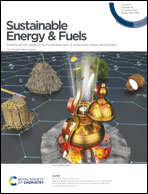New insights into the structure and catalytic performance of alizarin–zirconium hybrids for Meerwein–Ponndorf–Verley reductions: first-principles approach†
Abstract
A novel bifunctional mesoporous zirconium–alizarin (Zr–AZN) hybrid was successfully synthesized by using a template-free self-assembly method. Systematic characterizations demonstrated that the catalyst possessed abundant acid–base couple sites (density: 0.47 vs. 0.79 mmol g−1, acid/base molar ratio: 0.59) and high porosity. Zr–AZN exhibits superior catalytic activity toward the Meerwein–Ponndorf–Verley (MPV) reduction of different biomass-derived carbonyl compounds compared to other catalysts, especially of ethyl levulinate (EL) to γ-valerolactone (GVL), in quantitative yields (96%) with a high GVL formation rate of 1205 μmol g−1 h−1 and TOF of 0.47 h−1. Theoretical calculations show that the structure of Zr–AZN with the highest catalytic activity originates from the complexation that occurs at the 1,2-dihydroxyl (catechol) group, instead of the 1-hydroxy-9-keto group. Furthermore, it also presents a higher activity and selectivity and a lower computed apparent activation free energy (19.4 vs. 29.3 kcal mol−1) for the hydrogenation of EL compared to Sn–AZN.



 Please wait while we load your content...
Please wait while we load your content...